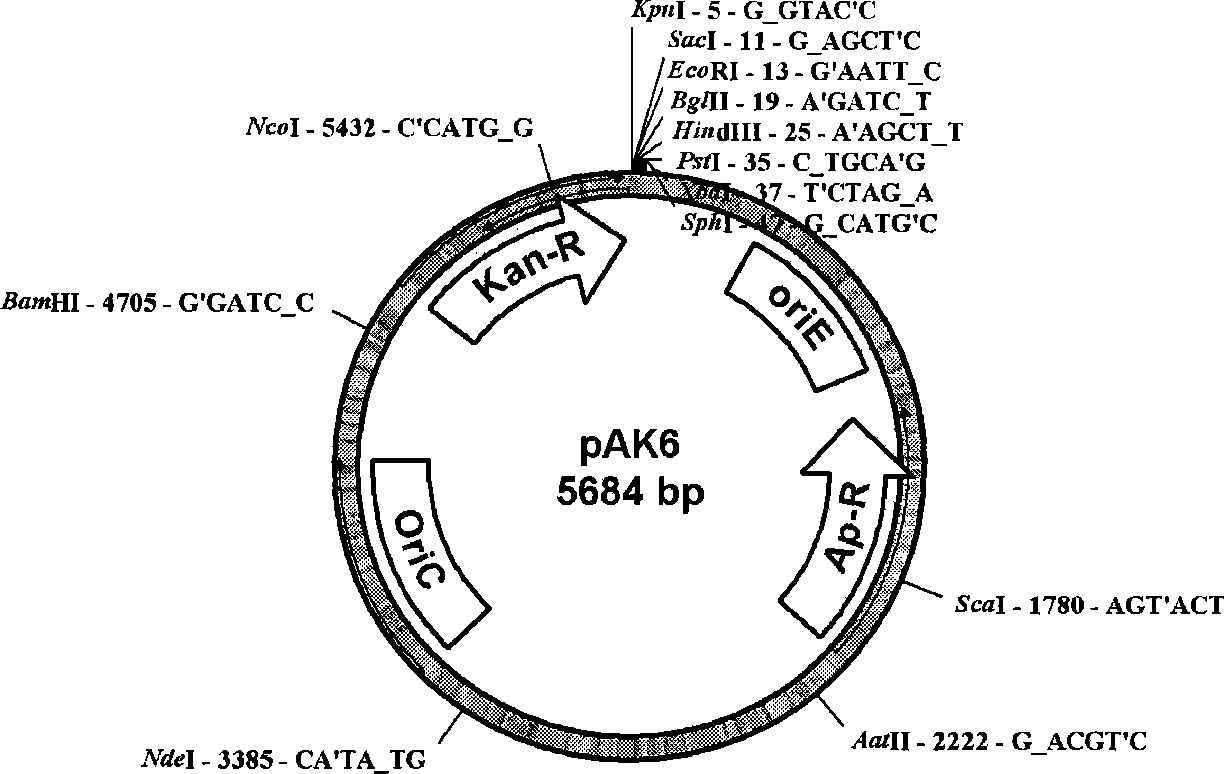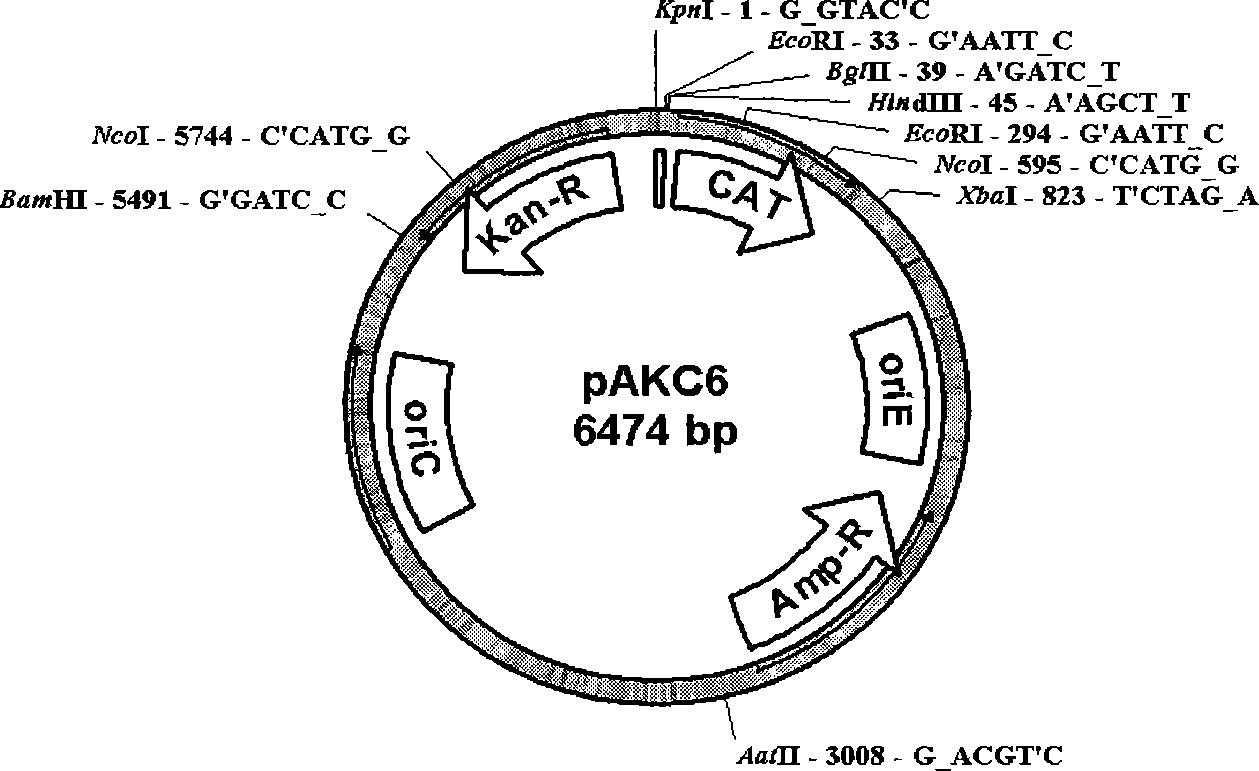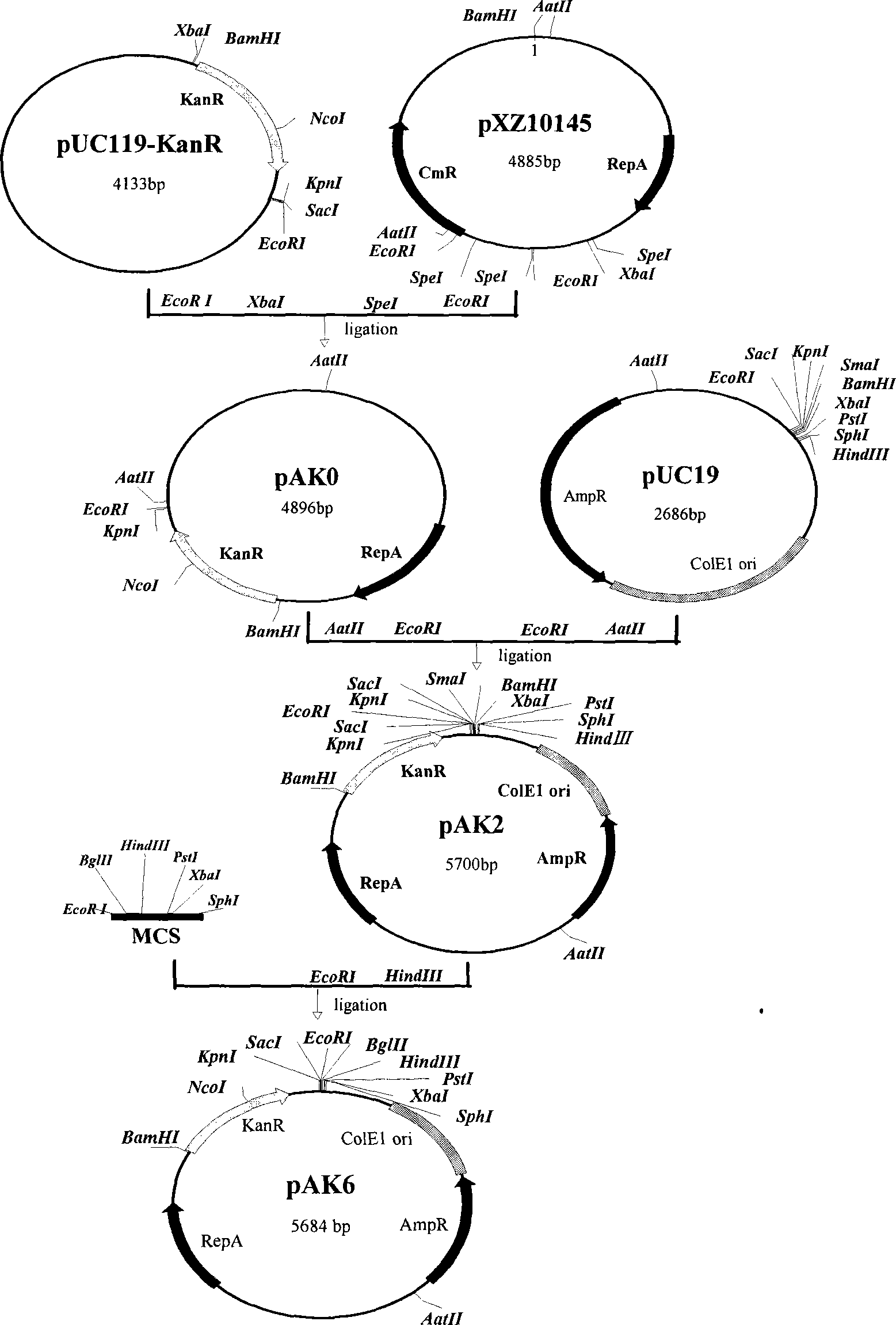Shuttle plasmid and derivative plasmid thereof
A technology of shuttle plasmids and plasmids, applied in the direction of using vectors to introduce foreign genetic material, recombinant DNA technology, etc.
- Summary
- Abstract
- Description
- Claims
- Application Information
AI Technical Summary
Problems solved by technology
Method used
Image
Examples
Embodiment 1
[0033] Example 1. Construction of plasmid pAK6
[0034] The construction process of plasmid pAK6 is as follows image 3 As shown, the specific method is as follows:
[0035]Taking the Corynebacterium glutamicum plasmid pXZ10145 (Shen Tianxiang et al. 1993 Journal of Bioengineering 9.216-222) (Institute of Microbiology, Chinese Academy of Sciences) as the starting plasmid, the plasmid pXZ10145 was digested with EcoRI / SpeI, separated by agarose gel electrophoresis, and recovered Large fragment with the starting point of replication. The E. coli plasmid pUC119-KanR (Guoqing Niu et al 2006 Metabolic Engineering 8.183-195) (Institute of Microbiology, Chinese Academy of Sciences) was digested with EcoRI / XbaI double enzymes, and small fragments with KanR gene were recovered. Connect the two fragments to construct a recombinant plasmid. The recombinant plasmid was transformed into Corynebacterium glutamicum ATCC 13032, and the plasmid was extracted and named pAK0. In order to introduce th...
Embodiment 2
[0036] Example 2. Construction of plasmid pAKC6
[0037] The construction process of plasmid pAKC6 is as follows Figure 7 As shown, the specific method is as follows:
[0038] To construct a promoter detection vector, the reporter gene chloramphenicol acetyltransferase gene CAT and the transcription terminator T of the Corynebacterium glutamicum LeuB gene were introduced into the plasmid pAK6 leuB . First, the coding region and SD of the chloramphenicol acetyltransferase gene (GenBank No.AT219685) were amplified from the plasmid pXC99E (Kirchner O and Tauch A 2003 J. Biotechnology 104: 287-299) (Institute of Microbiology, Chinese Academy of Sciences) by PCR sequence. The primers used are
[0039] P1: 5′-GGG AAGCTT AAGTAATTAACAGGAGCTAAGGAAGCTAAA-3′ and
[0040] P2: 5′-AAC TCTAGA TAAGGGATTTTGGTCATGCG-3', the underlined parts are the recognition sites of HindIII and XbaI, respectively.
[0041] The reaction system is: total volume 50μL, 2×GC bufferII 25μL, dNTP 7μL, LA Taq DNA pol...
Embodiment 3
[0049] Example 3. Plasmids pAK6 and pAKC6 are replicated in theta mode
[0050] 1. Stability experiment of plasmid pAK6 and pAKC6
[0051] Plasmid pUL340 is a rolling circle replicating plasmid. With plasmid pUL340 as a control, the stability of plasmids pAK6 and pAKC6 was determined. Methods as below:
[0052] 1) Using Corynebacterium glutamicum ATCC 13032 as the host of plasmid pUL340 (Ramon I. Santamaria et al 1985 J. Bacteriology Vol. 162 No. 1. p. 463-467) (Institute of Microbiology, Chinese Academy of Sciences), pAK6 and pAKC6.
[0053] PUL340, pAK6 and pAKC6 were respectively introduced into Corynebacterium glutamicum ATCC 13032 to obtain recombinant bacteria pUL340 / 13032 containing pUL340, recombinant bacteria pAK6 / 13032 containing pAK6 and recombinant bacteria pAKC6 / 13032 containing pAKC6.
[0054]Single colonies of pUL340 / 13032, pAK6 / 13032 and pAKC6 / 13032 were respectively inoculated into LB medium containing 50μg / ml kanamycin and cultured at 30°C to logarithmic phase, a...
PUM
 Login to View More
Login to View More Abstract
Description
Claims
Application Information
 Login to View More
Login to View More - R&D
- Intellectual Property
- Life Sciences
- Materials
- Tech Scout
- Unparalleled Data Quality
- Higher Quality Content
- 60% Fewer Hallucinations
Browse by: Latest US Patents, China's latest patents, Technical Efficacy Thesaurus, Application Domain, Technology Topic, Popular Technical Reports.
© 2025 PatSnap. All rights reserved.Legal|Privacy policy|Modern Slavery Act Transparency Statement|Sitemap|About US| Contact US: help@patsnap.com



